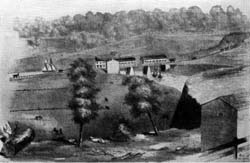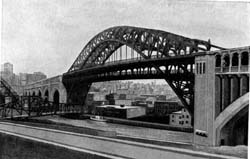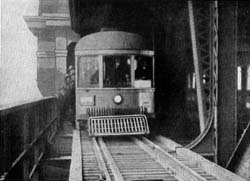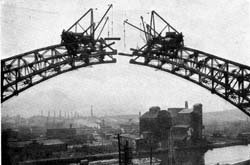|
THE ORIGINAL COLUMBUS STREET BRIDGE FROM DETROIT AVENUE
Bridges of Cleveland and Cuyahoga County, 1918 THE NEW DETROIT-SUPERIOR HIGH LEVEL BRIDGE By Stanley L. McMichael Linking the east and west sides of Cleveland with a broad ribbon of concrete and steel, the new Detroit-Superior high level viaduct, completed during the year 1918, stands as a splendid monument to the enterprise and aggressive action of the citizens of Cuyahoga County. Nowhere in America does there exist at the present day any bridge or viaduct that can rival, in artistic design, usefulness and permanency of construction, this massive span which binds together the two most populous sections of the metropolis of the middle west. Successfully completed, after years of agitation, study and diligent effort, the new viaduct is regarded as one of the finest specimens of engineering art to be found anywhere in America. It is the largest double deck reinforced concrete bridge in the world. Unusual technical difficulties have been overcome, large sum of money have been expended, and now at the time of its formal dedication, it stands a structure that promises to endure for generations to come. No expense has been spared, nothing has been left undone to make it worthy of the purpose for which it was built. Officials of the city of Cleveland and Cuyahoga have worked faithfully to bring this great structure into being. The most modern methods have been followed and the result after five years of labor is a structure of pleasing and harmonious design, the beauty and utility of which is apparent to everyone. The general route followed has been in use as a highway east and west for a century and a quarter, harking back to the closing years of the eighteenth century when locations at both ends of the viaduct comprised the camping grounds of Indians. It passes the spot where Cleveland’s first bridge was constructed and is now the principal gateway from the populous downtown business dis-
trict, to the great residential sections lying west of the Cuyahoga River, crossing the busy valley wherein are located some of the city’s largest industrial plants. The high level bridge, extending from the center line of West 9th Street to the intersection of West 25th Street and Detroit Avenue, is 3,112 feet long. The actual cost of the big bridge, including the land purchased as a right of way, was $5,407,000, of which $1,687,200 was for land and $3,719,800 for superstructure. It embraces twelve huge concrete arches and one steel span 591 feet long which bridges the Cuyahoga River and which alone cost $646,747. CENTRAL STEEL SPAN IN THE NEW BRIDGE The maximum height of the central span above the river is 196 feet and the minimum clearance for lake vessels is 96 feet. The main upper deck is 75 feet wide, permitting two 15-foot sidewalks and a 45-foot roadway. Provision is made on a deck constructed directly beneath the roadway for six street car tracks. Four sets of these tracks have been installed and there is room for two more to be added when needed. About 2,123,300 cubic yards of concrete and 9,385,000 pounds of reinforcing steel were utilized in its construction. The concrete piles used in the foundation work, if placed end to end. would extend a distance of twenty-eight miles. Each end of the huge structure is provided with under-
ground street car station for the use of passengers desiring to board the cars operating on the lower deck. The bridge was built by Cuyahoga County, of which Cleveland is the county seat. Under a court decision rendered several years ago, the county was authorized to expend money within the city limits on through market roads. As Superior and Detroit Avenues are both county thoroughfares, it was deemed fitting that a great bridge might be built at county expense for the purpose of joining these two important highways. The city of Cleveland co-operated in the removal of underground pipe and wire obstructions and the re-routing of street car traffic. Original plans did not contemplate the construction of subway entrances, but after the bridge was gotten under way, it was determined that subways would ad greatly to its value and eliminate traffic congestion at both ends. Provisions was thereupon made to construct a four-track subway, entering the lower level at West 6th Street and two double-track subways at the westerly end, one rising to the surface on West 25th Street near Church Avenue and the other emerging on Detroit Avenue near West 29th Street. STREET CAR TRACK ON LOWER DECK In constructing the bridge, it was necessary to build twelve concrete arches in clear span width from 58 to 174 feet. All except one are of the same general type. The arches consist of four ribs, each reinforced at points where possible tension may occur. The arch spanning the tracks of the Big Four and Erie Railways had to be of a different construction because the clearance required over the tracks did not permit the use of arch centering. Accordingly, three hinged steel arches of a greater rise, the lower deck being carried through, were used to carry the weight of the concrete while it was poured around these steel arches.
The west abutment and piers Nos. 5 to 11 inclusive, rest on precast reinforced concrete piles varying in length from twenty-five to fifty feet. These piles, under test, were required to carry a load of sixty tons for seven days, with a maximum allowed settlement of one-quarter of an inch. Piers Nos. 1 and 2 were carried down from 35 to 40 feet into the natural stratum of clay, bringing the footings of the piers 60 to 65 feet below the surface grade of the ground. These piers are of caisson type built in crib form, of reinforced concrete. The superstructure east of the river was erected with the aid of a double cableway, having a span between towers of 1,200 feet. The steel head tower was 180 feet high and the main cables two and a half inches in diameter. The cableway had and ordinary carrying capacity of eight tons, but handled as high as twelve and a half tons in emergencies. LOOKING THROUGH STEEL ARCH A complete saw mill plant and framing plant and farming yard was maintained to build forms, the material being carried to place by the cableways. The most striking feature of the big bridge, perhaps, is the huge steel span in its center, consisting of a 591-foot steel arch. It is a double decked, three hinged arch, and, like the approaches, carries the roadway and two 15-foot sidewalks on the upper deck, and six street car tracks on the lower level. The arch is designed to carry a load of 10,000 pounds per lineal foot of bridge plus impact varying for different positions. The span trusses are of nickel steel, other parts being of carbon steel. The steel arch has a rise of 144 feet, a depth at the crown of twenty feet and a depth at the end hangers of ninety-one feet. The massive arch was erected from each river pier as a cantilever, anchored through back stays to the main concrete piers. The erection of
each arm was started from ninety-foot steel towers erected just back of the abutment piers, the traveler and its two stiff-legged derricks being sustained by these towers. Engineers had computed that when the trusses were finally placed and before being lowered to take bearing on the center pin the bearing faces would be about twenty inches apart. When the last section in the trusses had been placed the two halves lined up within one-eighth of an inch, which difference was easily adjusted by means of a cable. They were within twenty-two inches of bearing when lowering operations began. It was fascinating to watch the two great trusses, each 290 feet long and weighing about 2,000 tons, slowly settle into position. No movement could be seen, but the space between the two ends gradually lessened until they touched, and the arch took its position. Final adjustment varied but two inches with the computations, in a total span of 591 feet! The marvelous manner in which they proved out was a subject of favorable comment by many eminent engineers who watched the progress of construction of the arch. The total weight of steel in the central span is 8,500,000 pounds. There were 195,000 pounds of rivets used in the field joints and 45,000 pounds of paint were required to cover the big arch. Following the completion of the reinforced concrete arches in the approaches and of the main central arch, earth fills were made between walls at each end of the bridge, the decks were carefully waterproofed and pavements were laid. Balustrade of limestone followed and, finally attractive ornamental lamps were set in place. The bridge is probably one of the best illuminated of any similar structure in America. The approaches at each end of the bridge flare slightly, giving it an unusually broad and open appearance as one approaches. There is an air of permanency and solidity about the entire structure that is satisfying and one approaches the fact that aesthetic design has not been sacrificed to mere utility. While a number of Cleveland organizations and individuals heartily co-operated in the movement to build the new structure particular credit must nevertheless be give to the officers and members of The Cleveland Chamber of Industry, who worked untiringly for the passage of the bond issue which made the big bridge a possibility, and who enthusiastically supported in every way its construction and ultimate completion.
THE NEW DETROIT-SUPERIOR HIGH LEVEL VIADUCT ENDS OF STEEL ARCH TO BE JOINED
SUBWAY APPROACH FROM DETROIT AVENUE
|
||
| NEXT CHAPTER | PREVIOUS CHAPTER | TABLE OF CONTENTS |
|
||







